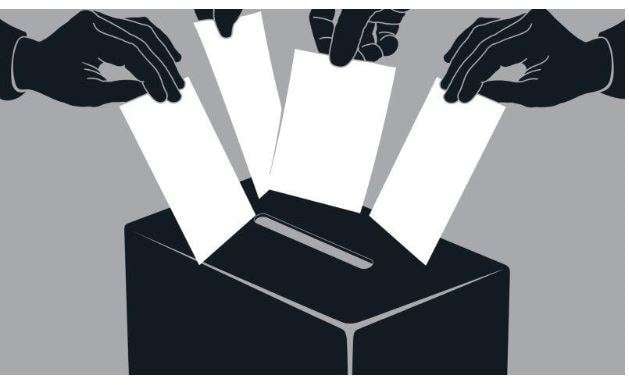IN WHOSE INTEREST
Part: Systemic Crisis of Estonia’s E-Voting System: From the Constitution to Technical Deficiencies
Estonia’s e-voting system, long considered a flagship of the digital society, faces fundamental problems that stretch from technical security to constitutional principles. This analysis is based on expert assessments, court documents, and legal acts. We discuss a system that threatens the legitimacy of democratic elections in Estonia.
🫵 Constitutional Issue: The One-Day Rule
The Constitution of the Republic of Estonia § 60 clearly states:
“Regular elections of the Riigikogu shall be held on the first Sunday of March in the fourth year following the previous election year.”
The Constitution requires elections to be held on one day, but the current e-voting system allows voting over several days (usually from Monday to Saturday). This creates a constitutional conflict that the Supreme Court has not yet addressed.
If the election procedure contradicts the Constitution, only the Constitution is valid!
🫵 Technical Security Problems
👉 Expert Criticism
International experts have found several serious security issues in Estonia’s e-voting system:
-
System aging: Experts noted that the system is “dangerously outdated.”
-
Ease of manipulation: University of Michigan’s Associate Professor J. Alex Halderman and Finnish expert Harri Hursti were “shocked at how easy it was to alter e-voting results maliciously.”
-
Voter computer vulnerability: Compromising e-voters’ computers is easy and challenging to detect.
👉 IT Expert Evaluations
IT expert Kalevi Koplik identified the following systemic flaws:
-
Lack of “multiple eyes” rule: The critical system lacks adequate oversight.
-
Root certificate security: Questions about protecting the key that powers the digital state.
-
Test user issues: Uncertainty about how test users are excluded from voter lists.
-
Unverifiable software: During elections, verifying the software used is impossible.
-
Opaque network architecture: No documentation of the whole system architecture.
🫵 Lack of Transparency and Auditing
👉 Limited Role of Auditors
Märt Põder’s documentation shows that auditors’ roles are restricted:
“The auditor’s only duty is to be present during procedures”, and audits do not include the software itself.
👉 Observer Restrictions
A joint statement by observers of the 2023 parliamentary elections revealed:
-
Inability to observe devices and data flows throughout the e-voting process.
-
Inability to observe actual IT processes during e-voting.
-
Preparation of data carriers, server backups, and log creation was not observed.
🫵 Smartmatic and Venezuela Connection
👉 Joint Venture
In 2014, Smartmatic-Cybernetica Centre of Excellence for Internet Voting OÜ was established, with 60% owned by Netherlands-registered Smartmatic and 40% by Estonia’s Cybernetica AS. Although a Cybernetica representative claims Smartmatic had no role in Estonia’s voting app, the connection raises questions.
👉 Geopolitical Context and International Rejection
Smartmatic originates from Venezuela and was involved in Hugo Chávez’s voting system. The failure to export Estonia’s e-voting system to developed nations raises serious questions about its global reliability.
🫵 Netherlands’ Dramatic Experience
By the late 1990s, up to 90% of Dutch voters used kiosk-type (DRE) voting machines. However, following a political campaign in 2006–2007, NEDAP voting machines were phased out, and e-voting ended in 2009 due to concerns over security and transparency.
🫵 Experiences in Other Countries
👉 Norway:
Tested e-voting on a limited scale but abandoned it, citing that it did not increase voter turnout and could undermine election trust.
👉 Switzerland:
Abandoned it due to security concerns.
👉 Germany:
The Constitutional Court declared e-voting unconstitutional, based on the principle of public election transparency.
This pattern shows that developed democracies are abandoning e-voting systems, not embracing them.
🫵 Cybernetica’s Double Role
👉 Links to the Defense Industry
Cybernetica AS is significantly tied to Estonia’s defense sector:
-
Business lines include defense, space, and national security.
-
Awarded “Defender Supporter” status in 2023 and 2024.
-
Since 2009, their maritime radio communication and monitoring tech has been used to monitor Estonia’s sea border.
-
In 2011, they developed the Sharemind prototype for the U.S. DARPA.
This dual role—managing elections and serving defense—raises concerns.
We hope the company still develops honest and secure solutions.
🫵 Supreme Court Decision: Recognition of System Deficiencies
👉 Märt Põder’s Complaint
In its 2025 decision, the Supreme Court addressed Märt Põder’s complaint demanding verification of e-voting results. The ruling revealed fundamental flaws in the system:
👉 Supreme Court Acknowledges Lack of Verifiability
The final sentence of the four-page ruling is telling:
“The panel highlights that for better compliance with the principles of constitutional electoral rights and the rule of law, rules for determining electronic voting results should be more clearly stipulated in normative acts.”
👉 Practical Conclusions:
-
E-voting results CANNOT be verified after the fact
-
The election commission is NOT required to recount votes
-
The election commission is NOT required to prove the accuracy of the results
-
E-vote hard drives will soon be destroyed without any checks
🫵 “Broken Election Clock” Incident
Märt Põder’s long-term documentation accuses election service director Arne Koitmäe of lying about spot checks:
👉 Triple Ignoring:
-
Märt Põder raised the issue of the alleged checks.
-
Ago Samoson and Tarvo Treier confirmed such checks likely weren’t done.
-
Põder accused Koitmäe of outright lying.
Koitmäe never presented proof that the suspected checks were performed.
🫵 Deeper Meaning of the Supreme Court Ruling
👉 Essentially Admitted Flaws:
The Court’s decision admits that the current e-voting system does not meet constitutional standards:
👎 Lack of transparency
👎 Unverifiability
👎 Violation of the rule of law — insufficient legal remedies
👉 Dissenting Opinion by Justice Vahur-Peeter Liin
The dissent likely contains an even harsher critique (available in a separate document).
👉 Paradoxical Situation
The Supreme Court says the system is flawed—but still allows its use. A situation arises where the highest court says, “The system is inadequate, but carry on using it!”
🫵 CRITICAL ISSUE: Irreversible Data Destruction
👎 The most devastating aspect is that e-vote data is destroyed without any chance of future verification. This is not theoretical—it happens in every election!
As Märt Põder emphasized:
“Soon, hard drives containing e-votes will be destroyed, and we will never know whether they were counted correctly or not.”
👉 What This Means Practically:
-
All past election e-votes have already been destroyed.
-
There is nothing left to audit.
-
Potential errors, manipulation, or failures are gone forever.
-
No future audit can ever prove the results were correct!
👉 Comparison to Traditional Voting
Paper ballots and protocols can be verified even years later. E-voting creates an irreversible situation—data disappears immediately after results are announced.
👉 Fundamental Principle of Democracy Violated
A core principle of democratic elections is verifiability.
If data cannot be verified, it cannot be trusted!
Estonia’s e-voting system violates this principle every time it is used.
🫵 OSCE Expert Mission Concerns
👉 Delays and Silence
The OSCE expert mission, tasked with evaluating Estonia’s e-voting system, failed to deliver a report by the deadline. The Estonian government is silent, possibly indicating the delay is convenient for them.
👉 Attempts to Neutralize
There are signs the government is trying to neutralize the OSCE group, creating a “Potemkin village” and overwhelming it with pro-e-voting narratives to distract from real issues.
🫵 Democracy Score and Irreversible Loss
If only paper ballots are fully verifiable and transparent, then in the 2023 elections—where 49% of votes were cast electronically—Estonia’s democracy score was just 51%!
👉 The Real Problem is Deeper
Those 49% e-votes have already been destroyed and can never be verified again. This means half of Estonia’s elections are irreversibly unverifiable.
👉 Comparison to Authoritarian Regimes
Even in authoritarian countries, election data is preserved and can theoretically be audited. Estonia’s e-voting system makes its elections less verifiable than those of some dictatorships.
This raises serious questions about Estonia’s standing in international democracy indexes—how can a country be fully democratic if half of its elections are irreversibly unverifiable?
🫵 EU Geopolitical Aspect
The EU’s reaction to election outcomes that don’t align with its preferences (e.g., Georgia, Poland, Hungary) raises the question:
Could the e-voting system be a deliberate tool for “adjusting” results to suit EU interests?
👉 Mobile Voting Risks
The government plans to expand e-voting to mobile devices, which introduces even greater risks:
-
Increased manipulation opportunities (device always on hand)
-
Weaker security than desktops or laptops
-
Even fewer verification options
🫵 Conclusions and Recommendations
👎 Irreversible Damage
The most tragic part is that most of the damage is already done and cannot be undone. Many have suffered, legitimacy is at stake—yet those responsible have initiated no investigation.
All previous e-vote data has been destroyed:
-
2005 Local Elections – destroyed
-
2007 Parliamentary Elections – destroyed
-
2009 EU Elections – destroyed
-
2011 Parliamentary Elections – destroyed
-
2014 EU Elections – destroyed
-
2015 Local Elections – destroyed
-
2019 Parliamentary and EU Elections – destroyed
-
2021 Local Elections – destroyed
-
2023 Parliamentary Elections – destroyed
WHO HAS EVEN BEEN ELECTED AND TO WHERE?!
None of these elections is verifiable anymore. This is an irreversible loss of democracy.
🫵 Core Problems
-
Constitutional violation – multi-day elections contradict the Constitution.
-
Technical security flaws – the system is vulnerable and unverifiable.
-
Lack of transparency – observers cannot truly inspect the system.
-
Lack of accountability – no one is responsible for honest results.
-
Conflict of interest – the same company manages elections and defense tech.
👍 Solutions
-
Uphold the Constitution – elections must happen on one day.
-
Independent international audit – full access to the entire system.
-
Increase transparency – allow real oversight by observers.
-
Preserve data – enable post-election verification.
-
Avoid conflicts of interest – separate election and defense functions.
IF EVERYTHING WAS LEGAL AND HONEST—WHY ARE THE DATA HIDDEN AND DESTROYED?!
🫵 Summary
The Estonian e-voting system, once seen as a digital success story, is a destroyer of democratic accountability.
From constitutional violations to technical security flaws, lack of transparency, and irreversible data destruction, this system does not meet the standards of democratic elections.
The most devastating truth is that about 50% of Estonia’s most recent elections have already been destroyed and can never be verified again.
This is an irreversible loss to democracy.
As long as these fundamental issues remain unresolved, Estonia’s elections cannot be fully democratic.
The credibility and legitimacy of the state are at risk if we continue using a system that not only fails to guarantee fair elections but actively destroys the evidence needed to prove them.
The most critical question is not whether the system is secure—but whether we can ever prove it if all the evidence is destroyed.
It’s time to choose:
Either continue with the “experimental” e-voting system, which destroys democratic evidence, or return fully to paper voting, which ensures transparency and trust.
Democracy must not be an experiment in which evidence is destroyed.
With every additional use of e-voting, we destroy even more of our democratic heritage.
Every day we delay returning to paper voting is another day of irreversible loss of democratic control.
This article is based on publicly available documents, legislation, expert assessments, and published media analyses.







